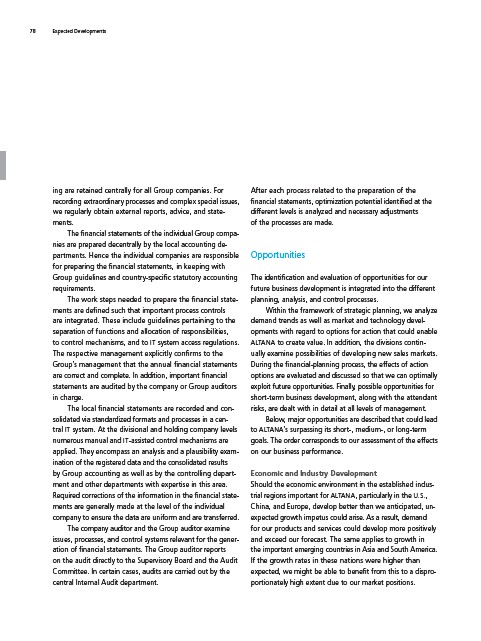
ing are retained centrally for all Group companies. For
recording extraordinary processes and complex special issues,
we regularly obtain external reports, advice, and statements.
The financial statements of the individual Group companies
are prepared decentrally by the local accounting departments.
Hence the individual companies are responsible
for preparing the financial statements, in keeping with
Group guidelines and country-specific statutory accounting
requirements.
The work steps needed to prepare the financial statements
are defined such that important process controls
are integrated. These include guidelines pertaining to the
separation of functions and allocation of responsibilities,
to control mechanisms, and to IT system access regulations.
The respective management explicitly confirms to the
Group’s management that the annual financial statements
are correct and complete. In addition, important financial
statements are audited by the company or Group auditors
in charge.
The local financial statements are recorded and consolidated
via standardized formats and processes in a cen-
tral IT system. At the divisional and holding company levels
numerous manual and IT-assisted control mechanisms are
applied. They encompass an analysis and a plausibility examination
of the registered data and the consolidated results
by Group accounting as well as by the controlling department
and other departments with expertise in this area.
Required corrections of the information in the financial statements
are generally made at the level of the individual
company to ensure the data are uniform and are transferred.
The company auditor and the Group auditor examine
issues, processes, and control systems relevant for the generation
of financial statements. The Group auditor reports
on the audit directly to the Supervisory Board and the Audit
Committee. In certain cases, audits are carried out by the
central Internal Audit department.
After each process related to the preparation of the
financial statements, optimization potential identified at the
different levels is analyzed and necessary adjustments
of the processes are made.
Opportunities
The identification and evaluation of opportunities for our
future business development is integrated into the different
planning, analysis, and control processes.
Within the framework of strategic planning, we analyze
demand trends as well as market and technology developments
with regard to options for action that could enable
ALTANA to create value. In addition, the divisions continually
examine possibilities of developing new sales markets.
During the financial-planning process, the effects of action
options are evaluated and discussed so that we can optimally
exploit future opportunities. Finally, possible opportunities for
short-term business development, along with the attendant
risks, are dealt with in detail at all levels of management.
Below, major opportunities are described that could lead
to ALTANA’s surpassing its short-, medium-, or long-term
goals. The order corresponds to our assessment of the effects
on our business performance.
Economic and Industry Development
Should the economic environment in the established industrial
regions important for ALTANA, particularly in the U.S.,
China, and Europe, develop better than we anticipated, unexpected
growth impetus could arise. As a result, demand
for our products and services could develop more positively
and exceed our forecast. The same applies to growth in
the important emerging countries in Asia and South America.
If the growth rates in these nations were higher than
expected, we might be able to benefit from this to a disproportionately
high extent due to our market positions.
78 Expected Developments